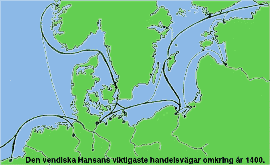Meet the Middle Ages
BackTrade and merchandise

A huge amount of merchandise was shipped across the Baltic Sea. The Hanseatic League controlled everything - what goods was exported and imported, the trading routes and the prices. The Hanseatic merchants also made sure that the ware was of good quality so that the buyers would be satisfied.
A lot of products and raw materials were in demand on the European continent: limestone from Öland and Gotland for the building of churches, iron from Småland for churches and houses, horses from Öland, butter and meat from the Swedish interior, herring from Skåne and Öland, grain from Sweden and Russia, flax from the Baltic countries, skins and fur from Russia. The needs and demands of the growing populations of Germany and France, the Church and the town builders were great.
Merchandise was also exported to the north from continental Europe. There was salt and beer from Germany, wine from Germany and France, woollen cloth from Flanders and spices from the Mediterranean. Spices and silks were also imported from far-away places such as India and China. Everything passed through the towns of Lübeck, Rostock, Greifswald, Stralsund and Danzig in the north of Germany.